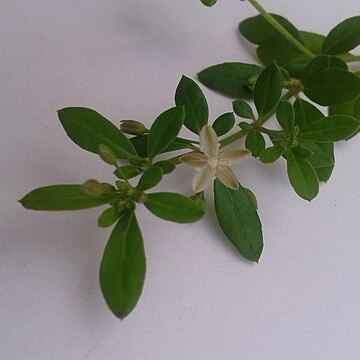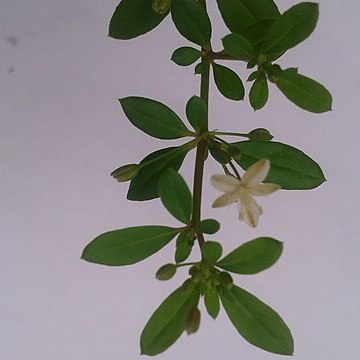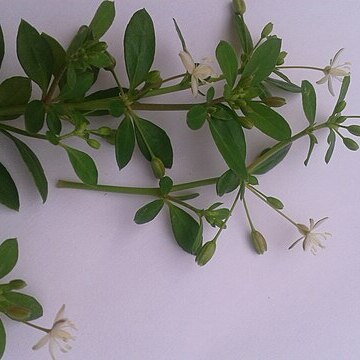A small glabrous herb with many slender rather rigid pale brownish upright or ascending stems 4–17 cm. long.. Leaves sessile, often glaucous; the basal rosetted, linear, oblanceolate, or spathulate, often quickly withering, 2–26 mm. long, 0.3–3 mm. wide; the cauline whorled, linear, up to 18 mm. long and 1.2 mm. wide.. Inflorescences axillary or terminal, sessile or pedunculate, umbelliform, 1–4-flowered.. Peduncle up to 20 mm. long.. Pedicels 5–15 mm. long.. Flowers greenish.. Sepals 5, 1–3 mm. long.. Stamens 5, sometimes 3 or 10.. Carpels 3, stigmas 3, short.. Seeds brown, compressed.. Fig. 5/12–13, p. 14.
Herbs small, to 8 cm. Root thin. Stems numerous, ascending, thin, stiff. Leaves sessile, basal leaves in a rosette; cauline leaves in pseudowhorls of 3-10, gray-green, linear, 5-10 × 0.3-0.5 mm, apex acute. Inflorescences terminal or seemingly axillary, trichotomous umbellate cymes. Pedicel 7-8 mm, thin, stiff. Tepals 5, elliptic to oblong, 2-2.5 mm, midvein green, margin white membranous. Stamens 3-5, shorter than tepals. Styles 3, short. Capsule broadly ellipsoid, ca. as long as tepals or slightly shorter. Seeds numerous, brown, slightly shiny, D-shaped, ca. 0.2 mm, reticulate. Fl. Jun-Jul. 2n = 18.
Plants erect, 3-20 cm. Leaves glaucous, in whorls of 4-12, basal rosette present; petiole 0.8-1.1 mm; blade linear to spatulate, 3-15 × 1-5 mm, base cuneate, apex acute to obtuse. Inflorescences: flowers in groups of 3-4 in stalked, axillary and terminal umbellate cymes. Flowers: sepals pale green, glaucous abaxially, white adaxially, elliptic to obovate, 1-1.5 × 1-1.6 mm, margins white, membranous; stamens 5, alternate with sepals; pedicel erect to spreading, 3-11 mm. Capsules subglobose, 1.5-1.8 × 1.5-1.9 mm. Seeds 20-40, brown, finely reticulate, 0.3-0.4 × 0.2-0.4 mm. 2n = 18.
A small herb. It grows 7-8 cm high. The root is thin. There are many stems which curve upwards. They are thin and stiff. The leaves do not have stalks. The leaves at the base are in a ring. There are 3-10 leaves up the stalk. They are narrow. They are 5-10 mm long by 0.3-0.5 mm wide. The flowering stalks are at the top or in the axils of leaves and in 3 stalked arrangements. These form flat topped clusters. The fruit is a capsule about 2-3 mm long. There are many brown seeds. They are D shaped and about 0.2 mm across. Possibly now Hypertelis cerviana (L.) Thulin.
Leaves sessile, often glaucous; basal ones 2–25 × 0·3–5 mm., linear, spathulate, obovate or oblanceolate, forming a rosette; cauline ones 3–18 mm. long, in whorls of c. 6 per node, linear.
A small glabrous many-stemmed annual herb with slender stems up to 20 cm. high, rather rigid, pale brownish, upright or ascending.
Inflorescences terminal and axillary, sessile or pedunculate, umbelliform, 1–4-flowered; peduncle up to 20 mm. long.
Flowers greenish-white, on slender, straight, rather rigid pedicels 5–18 mm. long, usually exceeding the leaves.
Perianth-segments 1–3 mm. long, green, sometimes with a brown keel.
Seeds brown, compressed, triangular in outline, shining.
Fruit ± globose, as long as the perianth.
Carpels 3 with 3 short stigmas.
Stamens (3)5(10).



